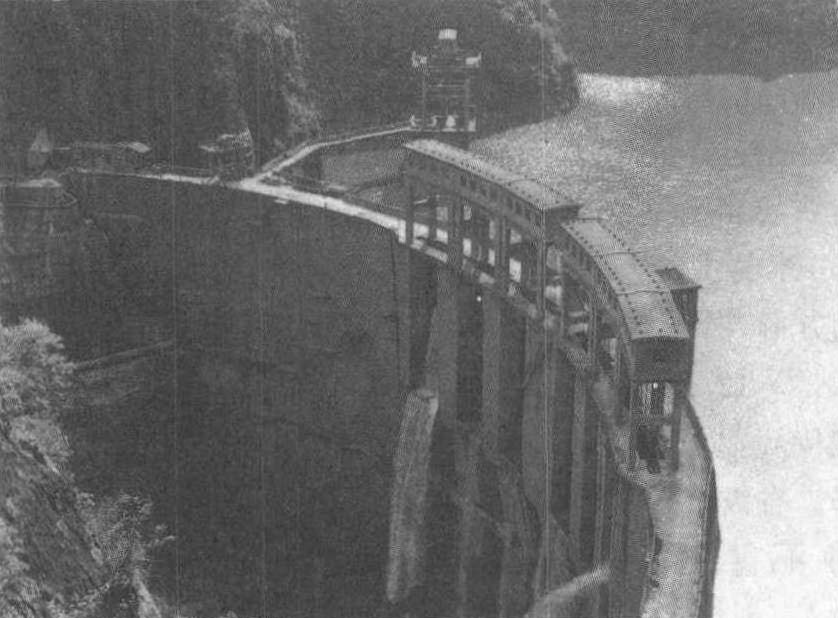石门水库
石门水库横跨龙潭、大溪两个乡镇,是台湾著名的人工湖之一,兼有发电、灌溉、防洪、观光等多方面的效用。
游览景点大多集中在水库大坝附近。坝顶有一座高台,高耸峙立,登高远眺,远山近水,秀丽的风景如诗如画。坝下六条并排的溢洪道像特大号的滑梯,一遇山洪即可开闸,顿时六条蛟龙奔腾而出。在其下游建有七彩喷水池,飘玉飞银,甚为美观,池畔坐落一凉亭,为牌坊式水池建筑,新颖大方。大坝附近饭店、旅馆林立,各式的公园、游乐园相继开放,为水库景区增添了许多热闹。如果乘游艇观光,则为另一趣事,湖面波光粼粼,两岸青峰翠峦,“青山环水水环天”,使人心摇神荡。水库南端有个小小的半岛,阳光下好似一颗莹洁玉盘上的绿珍珠,人称“仙岛”,百花繁茂,别有洞天。东边的阿姆坪,则是垂钓、露营、划船的好地方。
在玩赏之余最重要和诱人的是自然美食“活鱼多吃”,从早期的“活鱼三吃”到近期的“活鱼多吃”,花样千变万化,五花八门,许多美食家不为玩赏只为纯吃鱼鲜而来。
大坝区可眺望水库全景,并可乘船游湖,或搭船到阿姆坪露营、烤肉。此外,水库边还有龙珠湾、童话世界等游乐区,可顺便一游。至于到石门吃活鱼则是食客最爱之一,由于石门水库水质洁净,因而鱼只肥硕,肉质鲜美,成为本地最有名特产。
石门水库的大坝景观雄伟,最大溢洪量每秒11400立方尺。泻洪时景观宏伟。
石门水库
在大汉溪中游,地跨龙潭、大溪二镇。因溪水陡转北流处,有两山夹峙如门,故名。石门水库1955年动工,1963年完成。坝高133米,库容量为3.16亿立方米。溢洪道为鞍部泻槽式,设高10米、宽14米的弧形闸门6道。库区上有大湖,烟波浩渺,下有飞瀑,急腾怒泻,成为著名景区。游览点有大坝区、亚洲乐园、龙珠湾乐园、阿姆坪乐园、童话世界(原名金岛乐园)。大坝区筑有高台,游者登临,水光山色,尽收眼底。又设钓鱼浮台供垂钓者享受悠闲之乐。亚洲乐园前方水库流域宜做各种水上运动。童话世界占地45公顷,仿狄斯尼乐园。龙珠湾乐园傍山依水,隐密幽静,以休闲设施为主。阿姆坪乐园位于石门水库中游右岸,曲流蜿蜒,背山面水,是露营烤肉、踏青野游之胜地。
石门水库
以灌溉为主、结合发电的大型水利工程。枢纽工程位于汉中市汉江支流褒河上,拦河坝为高88米的双曲拱混凝土坝,总库容1.05亿立方米,干渠总引水量每秒56立方米,设计灌溉面积51.5万亩,灌区范围涉及汉中、城固、勉县三县(市)。渠首电站总装机4.05万千瓦,设计年发电量1.4亿千瓦时。枢纽和渠道工程1973年建成受益,电站于1977年投产发电。为提高灌溉效益,在灌区内又陆续建成了56座小型水库、664口池塘,增加蓄水量4348万立方米;建抽水站171处,形成了蓄引提结合的灌溉网,粮食亩产由受益前的300公斤提高到1990年的813公斤。水库还兼有防洪和养鱼效益。每年汛期通过优化调度管理,发挥削峰错峰作用。如在1981年汉中地区特大洪水灾害中,石门水库削减洪峰流量每秒1390立方米,大大减轻了褒河下游和汉江上游的洪水灾害。1990年获得全国先进灌区和水利部一级管理单位称号。
